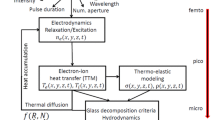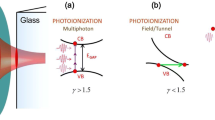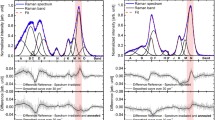Abstract
Optical devices fabricated by femtosecond (fs) laser within the Type II regime are of interest for high temperature applications (> 800 °C). fs-Type II regime is characterized by the formation of self-organized nanogratings, which are composed of regularly spaced porous nanolayers with nanopores having a typical size of a few tens of nm. In this work, we first investigate the evolution of the nanopore size distribution as a function of fs-laser writing speed and pulse energy, as well as a function of annealing temperature after fs-laser irradiation. Then, the thermal stability of such nanopores is numerically investigated through the use of the Rayleigh–Plesset (R–P) equation, and is compared with experimental data. The R–P equation provides insights into the temperature range at which the nanopores would ultimately collapse, serving as a design tool for future high temperature fs-Type II based devices. The key role of glass viscosity and nanopore diameter on the overall thermal stability is also discussed.





Similar content being viewed by others
Data availability
Not applicable.
Code availability
Not applicable.
References
M. Cavillon, M. Lancry, B. Poumellec et al., Overview of high temperature fibre Bragg gratings and potential improvement using highly doped aluminosilicate glass optical fibres. J. Phys. Photonics 1, 042001 (2019). https://doi.org/10.1088/2515-7647/ab382f
S.J. Mihailov, D. Grobnic, C. Hnatovsky et al., Extreme environment sensing using femtosecond laser-inscribed fiber bragg gratings. Sensors (2017). https://doi.org/10.3390/s17122909
J. Zhang, M. Gecevičius, M. Beresna, P.G. Kazansky, Seemingly unlimited lifetime data storage in nanostructured glass. Phys. Rev. Lett. 112, 1–5 (2014). https://doi.org/10.1103/PhysRevLett.112.033901
Y. Shimotsuma, P.G. Kazansky, J. Qiu, K. Hirao, Self-organized nanogratings in glass irradiated by ultrashort light pulses. Phys. Rev. Lett. 91, 247405 (2003). https://doi.org/10.1103/PhysRevLett.91.247405
S. Richter, C. Miese, S. Döring et al., Laser induced nanogratings beyond fused silica-periodic nanostructures in borosilicate glasses and ULETM. Opt. Mater. Express 3, 1161–1166 (2013). https://doi.org/10.1364/OME.3.001161
M. Lancry, F. Zimmerman, R. Desmarchelier et al., Nanogratings formation in multicomponent silicate glasses. Appl. Phys. B Lasers Opt. 122, 1–8 (2016). https://doi.org/10.1007/s00340-016-6337-8
E. Bricchi, P.G. Kazansky, Extraordinary stability of anisotropic femtosecond direct-written structures embedded in silica glass. Appl. Phys. Lett. 88, 2–4 (2006). https://doi.org/10.1063/1.2185587
S.-E. Wei, Y. Wang, H. Yao et al., Thermal stability of type II modifications by IR femtosecond laser in silica-based glasses. Sensors 20, 1–14 (2020). https://doi.org/10.3390/s20030762
J.J. Witcher, W.J. Reichman, L.B. Fletcher et al., Thermal annealing of femtosecond laser written structures in silica glass. Opt. Mater. Express 3, 502–510 (2013). https://doi.org/10.1364/OME.3.000502
J. Lu, M. Yang, D.N. Wang et al., Fiber Bragg gratings with enhanced thermal stability by residual stress relaxation. Opt. Express 17, 19785–19790 (2009). https://doi.org/10.1364/oe.17.019785
R.R. Thomson, P. Gillet, S. Mukherjee et al., Stress-state manipulation in fused silica via femtosecond laser irradiation. Optica 3, 1285 (2016). https://doi.org/10.1364/optica.3.001285
V.R. Bhardwaj, P.B. Corkum, D.M. Rayner et al., Stress in femtosecond-laser-written waveguides in fused silica. Opt. Lett. 29, 1312–1314 (2004). https://doi.org/10.1364/OL.29.001312
J. Tian, H. Yao, M. Cavillon et al., A comparison between nanogratings-based and stress-engineered waveplates written by femtosecond laser in silica. Micromachines 11, 1–11 (2020). https://doi.org/10.3390/mi11020131
M. Lancry, B. Poumellec, J. Canning et al., Ultrafast nanoporous silica formation driven by femtosecond laser irradiation. Laser Photonics Rev. 7, 953–962 (2013). https://doi.org/10.1002/lpor.201300043
J. Canning, M. Lancry, K. Cook et al., Anatomy of a femtosecond laser processed silica waveguide. Opt. Mater. Express 1, 998–1008 (2011). https://doi.org/10.1364/ome.1.000998
A.J. Berger, Y. Wang, D.M. Sammeth et al., Aqueous dissolved gas measurements using near-infrared raman spectroscopy. Appl. Spectrosc. 49, 1164–1169 (1995). https://doi.org/10.1366/0003702953965047
F. Zimmermann, Ultrashort Pulse Induced Nanostructures in Transparent Materials (Friedrich-Schiller-Universitat, Jena, 2017)
R. Desmarchelier, B. Poumellec, F. Brisset et al., In the heart of femtosecond laser induced nanogratings : From porous nanoplanes to form birefringence. World J. Nano Sci. Eng. 5, 115–125 (2015). https://doi.org/10.4236/wjnse.2015.54014
A. Rudenko, J.P. Colombier, T.E. Itina, Nanopore-mediated ultrashort laser-induced formation and erasure of volume nanogratings in glass. Phys. Chem. Chem. Phys. 20, 5887–5899 (2018). https://doi.org/10.1039/c7cp07603g
S. Richter, A. Plech, M. Steinert et al., On the fundamental structure of femtosecond laser-induced nanogratings. Laser Photonics Rev. 6, 787–792 (2012). https://doi.org/10.1002/lpor.201200048
M. Sakakura, Y. Lei, L. Wang et al., Ultralow-loss geometric phase and polarization shaping by ultrafast laser writing in silica glass. Light Sci. Appl. 9, 1–10 (2020). https://doi.org/10.1038/s41377-020-0250-y
M.S. Plesset, The dynamics of cavitation bubbles. J. Appl. Mech. 16, 277–282 (1949). https://doi.org/10.1080/15435075.2018.1431546
C.E. Brennen, Cavitation and Bubble Dynamics (Oxford University Press, Oxford, 1995)
K. Boyd, H. Ebendorff-Heidepriem, T.M. Monro, J. Munch, Surface tension and viscosity measurement of optical glasses using a scanning CO2 laser. Opt. Mater. Express 2, 1101–1110 (2012). https://doi.org/10.1364/ome.2.001101
V.A. Markel, Introduction to the Maxwell Garnett approximation: Tutorial. J. Opt. Soc. Am. A 33, 1244–1256 (2016). https://doi.org/10.1364/JOSAA.33.001244
M.J. Weber, Handbook of Optical Materials (CRC Press, London, 2003)
F. Zhang, Y. Yu, C. Cheng et al., Wavelength response and thermal stability of embedded nanograting structure light attenuator fabricated by direct femtosecond laser writing. Appl. Phys. B Lasers Opt. 117, 53–58 (2014). https://doi.org/10.1007/s00340-014-5797-y
M. Lancry, J. Canning, K. Cook et al., Nanoscale femtosecond laser milling and control of nanoporosity in the normal and anomalous regimes of GeO2-SiO2 glasses. Opt. Mater. Express 6, 321 (2016). https://doi.org/10.1364/OME.6.000321
B. Poumellec, M. Lancry, Kinetics of thermally activated physical processes in disordered media. Fibers 3, 206–252 (2015). https://doi.org/10.3390/fib3030206
M. Gecevičius, Polarization Sensitive Optical Elements by Ultrafast Laser Nanostructuring of Glass (University of Southampton, Southampton, 2015)
F. Zimmermann, M. Lancry, A. Plech et al., Femtosecond laser written nanostructures in Ge-doped glasses. Opt. Lett. 41, 1161–1164 (2016). https://doi.org/10.1364/ol.41.001161
M. Beresna, M. Gecevičius, P.G. Kazansky, T. Gertus, Radially polarized optical vortex converter created by femtosecond laser nanostructuring of glass. Appl. Phys. Lett. 98, 1–4 (2011). https://doi.org/10.1063/1.3590716
R. Desmarchelier, M. Lancry, M. Gecevicius et al., Achromatic polarization rotator imprinted by ultrafast laser nanostructuring in glass. Appl. Phys. Lett. 107, 181111 (2015). https://doi.org/10.1063/1.4934866
M. Gecevičius, M. Beresna, P.G. Kazansky, Polarization sensitive camera by femtosecond laser nanostructuring. Opt. Lett. 38, 4096–4099 (2013). https://doi.org/10.1364/ol.38.004096
R.J. Williams, R.G. Krämer, S. Nolte et al., Detuning in apodized point-by-point fiber Bragg gratings: insights into the grating morphology. Opt. Express 21, 26854–26867 (2013). https://doi.org/10.1364/oe.21.026854
E.N. Glezer, M. Milosavljevic, L. Huang et al., 3-D optical storage inside transparent materials. Opt. Lett. 21, 2023–2026 (1996)
E.G. Gamaly, S. Juodkazis, K. Nishimura et al., Laser-matter interaction in the bulk of a transparent solid: Confined microexplosion and void formation. Phys. Rev. B Condens. Matter Mater. Phys. 73, 1–15 (2006). https://doi.org/10.1103/PhysRevB.73.214101
Y. Wang, S. Wei, R.C. Yuta et al., Femtosecond laser direct writing in SiO2 -Al2O3 binary glasses and thermal stability of Type II permanent modifications. J. Am. Ceram. Soc. (2020). https://doi.org/10.1111/jace.17164
Funding
The authors would like to acknowledge the following institutions for funding their research: Agence Nationale pour la Recherche, FLAG/IR project, grant number ANR-18-CE08-0004-01 and CNRS Défi Instrumentation aux Limites, Ultrabragg project.
Author information
Authors and Affiliations
Corresponding author
Ethics declarations
Conflict of interest
The authors declare no conflict of interest.
Additional information
Publisher's Note
Springer Nature remains neutral with regard to jurisdictional claims in published maps and institutional affiliations.
Rights and permissions
About this article
Cite this article
Cavillon, M., Wang, Y., Poumellec, B. et al. Erasure of nanopores in silicate glasses induced by femtosecond laser irradiation in the Type II regime. Appl. Phys. A 126, 876 (2020). https://doi.org/10.1007/s00339-020-04062-8
Received:
Accepted:
Published:
DOI: https://doi.org/10.1007/s00339-020-04062-8




